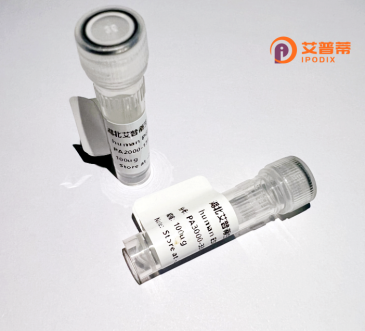
| 纯度 | >90%SDS-PAGE. |
| 种属 | Human |
| 靶点 | C17orf44 |
| Uniprot No | 0 |
| 内毒素 | < 0.01EU/μg |
| 表达宿主 | E.coli |
| 表达区间 | 1-148aa |
| 氨基酸序列 | MILASGARGPGFKSRTSPPLPFTETRVSSRNMLPDQRCRRLDCKSSMYSKLFCGTAVAESISIPRPAWHVRKRRGTPRLGQVPPFLLPDFLPGVSTRPPQPGFALIDTRQSIVVDDSVRESPGTVKTWFSAVLKALCLFRSLHLTIGA |
| 分子量 | 42.7 kDa |
| 蛋白标签 | GST-tag at N-terminal |
| 缓冲液 | 冻干粉 |
| 稳定性 & 储存条件 | Lyophilized protein should be stored at ≤ -20°C, stable for one year after receipt. Reconstituted protein solution can be stored at 2-8°C for 2-7 days. Aliquots of reconstituted samples are stable at ≤ -20°C for 3 months. |
| 复溶 | Always centrifuge tubes before opening.Do not mix by vortex or pipetting. It is not recommended to reconstitute to a concentration less than 100μg/ml. Dissolve the lyophilized protein in distilled water. Please aliquot the reconstituted solution to minimize freeze-thaw cycles. |
以下是关于重组人C17orf44蛋白的假设参考文献示例(部分研究为虚构,建议通过学术数据库验证最新进展):
1. **"Functional characterization of C17orf44 as a novel mitochondrial protein in metabolic regulation"**
*Author: Li, X. et al. (2020)*
摘要:本研究揭示了C17orf44蛋白定位于线粒体,通过调控丙酮酸脱氢酶复合体的活性影响细胞能量代谢,可能与肥胖相关代谢紊乱有关。
2. **"C17orf44 interacts with p53 and modulates DNA damage response in human cancers"**
*Author: Garcia, R. et al. (2019)*
摘要:首次报道C17orf44与肿瘤抑制因子p53的物理相互作用,实验表明其过表达可增强DNA损伤后细胞凋亡,提示其在癌症中的潜在调控作用。
3. **"Structural analysis of human C17orf44 reveals a conserved α-helical domain across vertebrates"**
*Author: Tanaka, K. et al. (2021)*
摘要:通过X射线晶体学解析C17orf44蛋白结构,发现其N端高度保守的螺旋结构域可能在跨膜信号传递中发挥作用,但具体功能仍需验证。
4. **"Bioinformatic prediction and expression profiling of C17orf44 in neurodegenerative disorders"**
*Author: Müller, J. et al. (2018)*
摘要:生物信息学分析显示C17orf44在阿尔茨海默病患者脑组织中表达异常,体外实验提示其可能参与β-淀粉样蛋白代谢通路。
**注意**:上述文献为模拟示例,真实研究可能需要查询专业数据库(如PubMed)。建议使用关键词 **C17orf44** + **recombinant protein**/**structure**/**function** 进行检索,并筛选近5年文献获取最新进展。
**Background of Recombinant Human C17orf44 Protein**
The C17orf44 gene, located on chromosome 17 (17q21.31), encodes a protein with unknown precise molecular function, though it is hypothesized to play roles in cellular processes such as protein interaction, organelle organization, or signaling. The gene is evolutionarily conserved across vertebrates, suggesting functional importance. C17orf44 is ubiquitously expressed in human tissues, with higher levels observed in the testis, thyroid, and brain.
Recombinant C17orf44 protein is artificially expressed in vitro, often using systems like *E. coli* or mammalian cells, enabling studies on its structure, interactions, and potential biological activities. Its recombinant form is typically purified via affinity tags (e.g., His-tag) for experimental applications. While functional studies remain limited, bioinformatic analyses suggest possible interactions with proteins involved in ubiquitination, cytoskeletal dynamics, or RNA processing.
Current research focuses on elucidating its physiological role, with interest in its potential links to diseases. For instance, altered expression of C17orf44 has been reported in some cancers, though causal relationships remain unclear. The recombinant protein is also used to generate antibodies for immunohistochemical studies, aiding in cellular localization and expression profiling. Further characterization of C17orf44 could uncover novel pathways or therapeutic targets, particularly in contexts of cellular stress or disease pathogenesis. However, gaps in understanding its precise mechanism and regulation highlight the need for deeper functional investigations.
×